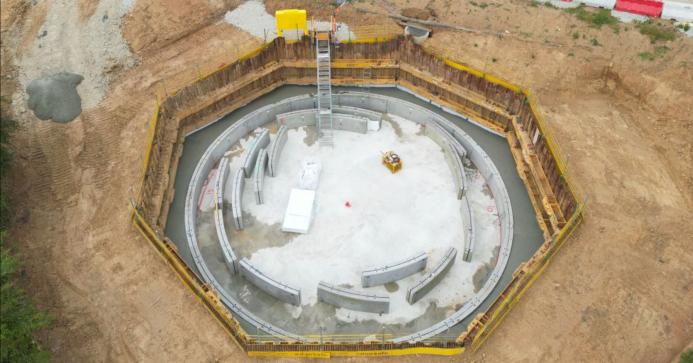Eight-sided support for Kent WWTW Project
Groundforce Shorco have delivered an efficient and space-saving solution for a wastewater treatment works (WWTW) project in Kent.
Clancy, the main contractor, is installing a new storm tank for Southern Water at the Westbere WWTW near Canterbury. The tank will handle surface water surcharges during heavy rainfall, helping to prevent raw sewage from being discharged into the nearby River Stour.
The tank consists of six precast concrete rings, each 15m in diameter, stacked to a depth of 6.5m. Each ring is made up of 16 interlocking caisson segments. These concrete segments are manufactured by FP McCann and supplied through heavy-side materials distributor Keyline.
For the tank, Clancy excavated an octagonal hole to a depth of 7m. Groundforce Shorco supported this excavation with 120 interlocking 6m GFI steel sheet piles, driven to a depth of 6m using an excavator-mounted vibrating hammer, the Mueller MS4, supplied by Groundforce’s Piletec division.
After installing the sheet-piled cofferdam, Clancy excavated to a depth of about 1m and then braced the top of the cofferdam using Groundforce Shorco’s modular hydraulic Mega Brace system. Clancy then continued to excavate to the formation layer before casting the base slab for the storm tank.
“The octagonal excavation makes sense for a circular tank,” explains Clancy project manager Oliver Smart. “It reduces the amount of excavated material and requires less equipment and materials.”
This design closely follows the tank’s perimeter while providing enough space for the bracing.
Groundforce Shorco area sales manager Arpad Nagy highlights the benefits: “The Mega Brace system is very adaptable and easy to install, regardless of the excavation shape. In this case, the octagonal shape reduced the excavated material by 20%, approximately 200 cubic metres. It also reduced the required sheet piling by 10 linear metres and the bracing by 30 linear metres, which lowers the carbon footprint and environmental impact.”

